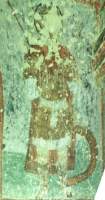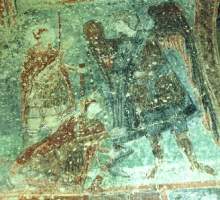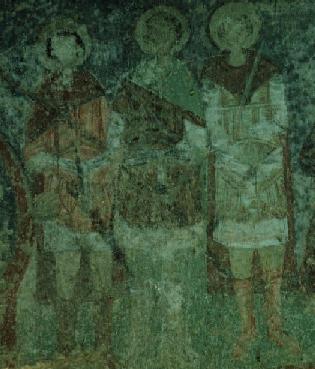
A typical landscape in the Goreme Valley
(photograph taken from the window of a rock-carved monastery)
| "Fairy Chimneys" |
 |
See, I told you they looked phallic!
The top layer of hard rock protects the softer tufa underneath until a crack or other fault allows water to seep through, beginning erosion of the lower layers.
Move on several million years, and the only intact sections of tufa are those where the harder rock is still in place. Such formations were ideally suited to hollowing out for dwellings, churches etc. The foliage at the bottom may be grape vines, which are grown as a prostrate plant in this region, not supported on espaliers. |
Over the centuries, the inhabitants have carved into the soft tufa to create dwellings for themselves, in the sides of cliffs, in "fairy chimneys" and large rock outcrops, and even, such as in Kaymakli, underground cities, up to seven levels deep and stretching for miles under the ground.
The isolation and solitude of central Kappadokia was an ideal environment for those who wished to get closer to God, and under the Byzantine Empire many monasteries and nunneries were carved out of the rock. As well as these a large number of churches were created, and their interior walls covered with murals.
| The "Dovecote" Church |
| The Dovecote Church - Exterior View |
 |
|
The Dovecote Church at Cavusin. If you look carefully, you can see the two angels described by Jerphanion in 1911-1912 on the stone panel just to the right of the doorway.
His photographs show these clear and in sharp detail, suggesting that the rock-fall which exposed them must have been recent.
Sadly, sun and weather have taken their toll - in this photograph, taken in 1992, the angels are faded and indistinct.
The side walls and the remnants of the vaulted roof of the narthex can also be seen, as described in Jephanion's report. (1) |
 The Dovecote Church, Cavusin. The remains of the two angels mentioned by Jerphanion can be seen to the right of the entrance. |
| Emperor Nikephoros II Phokas and his court |
 |
|
Nikephoros Phokas was a member of an old Anatolian aristocratic family. He was the second husband of Empress Theophano, and his right to the Imperium came through her.
He was Byzantine Emperor from 963-969 AD. It is thought that the pictures were done about the year 965 (Jerphanon p524).
The picture above shows Nikephoros in the centre, in crown and loros, in front of a throne decorated with pearls and perhaps gems.
To the right is a figure assumed to be his Empress, Theophano.
The two figures to the left are (far left) his father, Caesar Bardas Phokas, and his brother, the Kouropalates Leo Phokas. The Phokas family's power base was in the region in which this church is situated, and Jephanion believed that they may have donated toward the church, and that the picture records the donation (ibid). Nikephoros was a successful general, and should perhaps have been a more successful Emperor. But he was excessively pious and considerably older than his pleasure-loving Empress. His reign started well, but as years passed his rule became more and more arrogant and arbitrary. He finally came to a bad end - he was assassinated and mutilated by a coterie of officers under Theophano's lover John Tzimiskes, who took his place as Emperor but then consigned Theophano to a nunnery. He went on to become one of Byzantium's most successful and glorious emperors. |
An English translation of Jerphanion's report.
| The Military Saints |




Some of the most interesting depictions of Byzantine military equipment dated to the mid 10th century AD, are in the "Dovecote" church in Cavusin, carved into the side of a cliff, with the entrance high off the ground.
References:
1. de Jephanion, G. Les Eglises Rupestres de Cappadoce Librarie Orientaliste Paul Geuthner. Paris, 1932
| The "Hidden" Church |



Concealed in a cave on the reverse side of a cliff, this church contains murals of military saints, and one rather rare one of a soldier in a mail-shirt.
| I would like to acknowledge the help of Raffaele d'Amato in Italy who, having expressed interest in the photographs I'd taken of the Goreme valley murals, not only scanned them for me but sent me a copy at his own expense of Jerphanion's definitive two-volume text on the subject. His assistance and enthusiasm are greatly appreciated. |
by Steven Lowe
